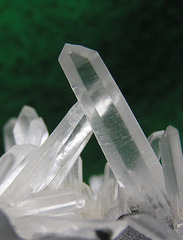Anne Elliott's photos with the keyword: minerals
Silver and gold
| 18 Oct 2012 |
|
I thought this was such a beautiful sight, looking down into the thermal water at Mammoth Hot Springs, Yellowstone National Park, Wyoming, US. It was taken somewhere near Canary Spring, on 12 September 2012, the second day of a week's holiday with friends from England.
"Mammoth Hot Springs is a large complex of hot springs on a hill of travertine in Yellowstone National Park ... It was created over thousands of years as hot water from the spring cooled and deposited calcium carbonate (over two tons flow into Mammoth each day in a solution). Although these springs lie outside the caldera boundary, their energy has been attributed to the same magmatic system that fuels other Yellowstone geothermal areas... A caldera is a cauldron-like volcanic feature usually formed by the collapse of land following a volcanic eruption. They are sometimes confused with volcanic craters."
en.wikipedia.org/wiki/Mammoth_Hot_Springs
For a diagram of the Hot Springs layout:
en.wikipedia.org/wiki/File:MammothHotSprings.JPG
Map of Yellowstone National Park:
hfc.nps.gov/carto/PDF/YELLmap2.pdf
Patterns, Mammoth Hot Springs
| 01 Nov 2012 |
|
So many beautiful patterns and textures are created around the various springs at Mammoth Hot Springs and other hot spring/geyser locations within Yellowstone National Park. This shot was taken from the boardwalk, looking over the railing, near the Main Terrace at Mammoth Hot Springs, on 12 September 2012.
"Mammoth Hot Springs is a large complex of hot springs on a hill of travertine in Yellowstone National Park ... It was created over thousands of years as hot water from the spring cooled and deposited calcium carbonate (over two tons flow into Mammoth each day in a solution). Although these springs lie outside the caldera boundary, their energy has been attributed to the same magmatic system that fuels other Yellowstone geothermal areas... A caldera is a cauldron-like volcanic feature usually formed by the collapse of land following a volcanic eruption. They are sometimes confused with volcanic craters."
en.wikipedia.org/wiki/Mammoth_Hot_Springs
For a diagram of the Hot Springs layout:
en.wikipedia.org/wiki/File:MammothHotSprings.JPG
Map of Yellowstone National Park:
hfc.nps.gov/carto/PDF/YELLmap2.pdf
Delicate layers
| 03 Nov 2012 |
|
One of the many patterns that have been formed around the hot springs at Mammoth Hot Springs, Yellowstone National Park, Wyoming, US. These were such beautiful, thin, delicate layers.
"Mammoth Hot Springs is a large complex of hot springs on a hill of travertine in Yellowstone National Park ... It was created over thousands of years as hot water from the spring cooled and deposited calcium carbonate (over two tons flow into Mammoth each day in a solution). Although these springs lie outside the caldera boundary, their energy has been attributed to the same magmatic system that fuels other Yellowstone geothermal areas... A caldera is a cauldron-like volcanic feature usually formed by the collapse of land following a volcanic eruption. They are sometimes confused with volcanic craters."
en.wikipedia.org/wiki/Mammoth_Hot_Springs
For a diagram of the Hot Springs layout:
en.wikipedia.org/wiki/File:MammothHotSprings.JPG
Map of Yellowstone National Park:
hfc.nps.gov/carto/PDF/YELLmap2.pdf
Crystals
| 25 Jun 2007 |
|
I seem to remember that this piece of mineral was from India. I don't think they are Quartz crystals, but I can't remember what they are. This was taken with supermacro - each crystal is very tiny, maybe a quarter to a half an inch. I actually used my old digital Olympus C750 UZ for this photo.
Fool's Gold
| 02 May 2007 |
|
|
I was an absolute fanatic of geology when I was in High School. Took it at "O" level (in England), though I was really at an "A" level. Collected various rocks and minerals for years, and I think my favourite is Iron Pyrites in its various forms - cubic, etc.. Unfortunately, I think my skin colour reflected in the many "faces" of this specimen when I took the photo. Love the way the tiny Quartz crystals have formed in little nooks and crannies, just like wildflowers will do.
Jump to top
RSS feed- Anne Elliott's latest photos with "minerals" - Photos
- ipernity © 2007-2025
- Help & Contact
|
Club news
|
About ipernity
|
History |
ipernity Club & Prices |
Guide of good conduct
Donate | Group guidelines | Privacy policy | Terms of use | Statutes | In memoria -
Facebook
Twitter





